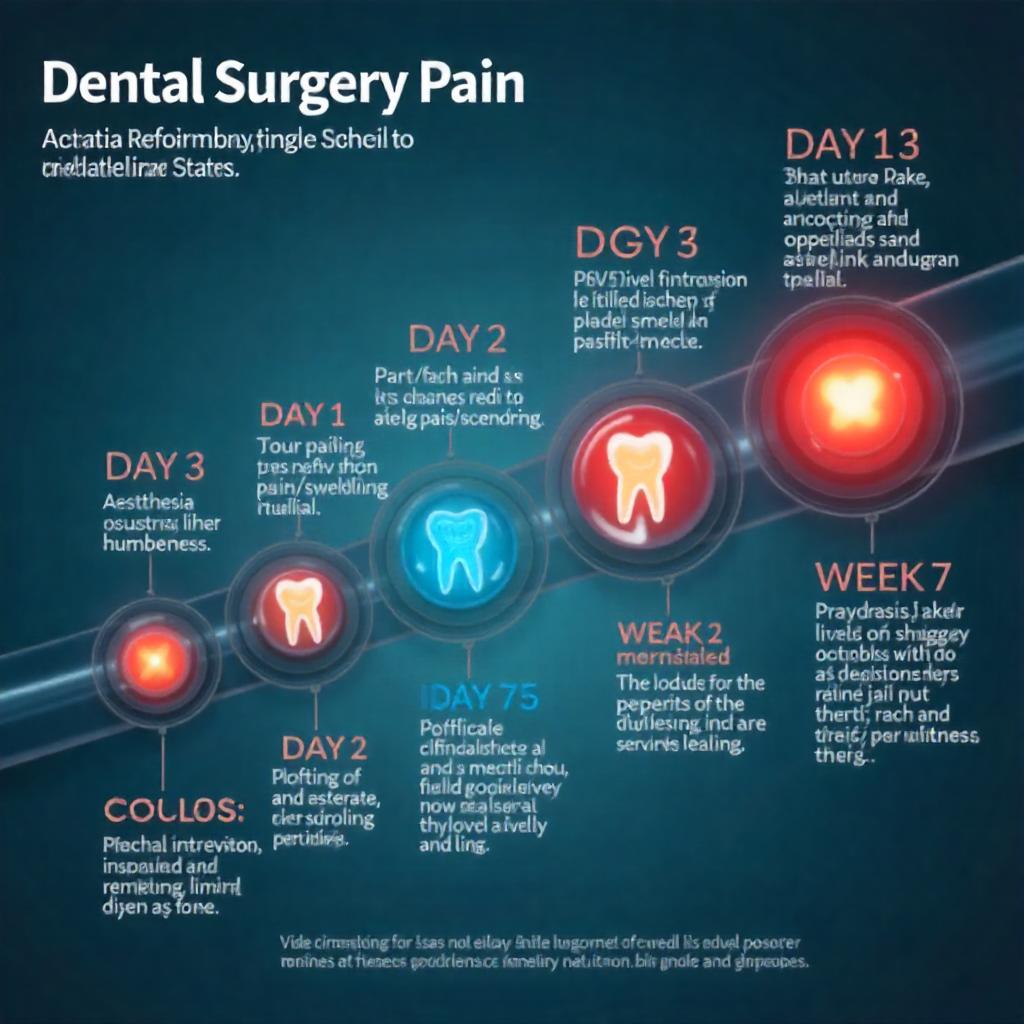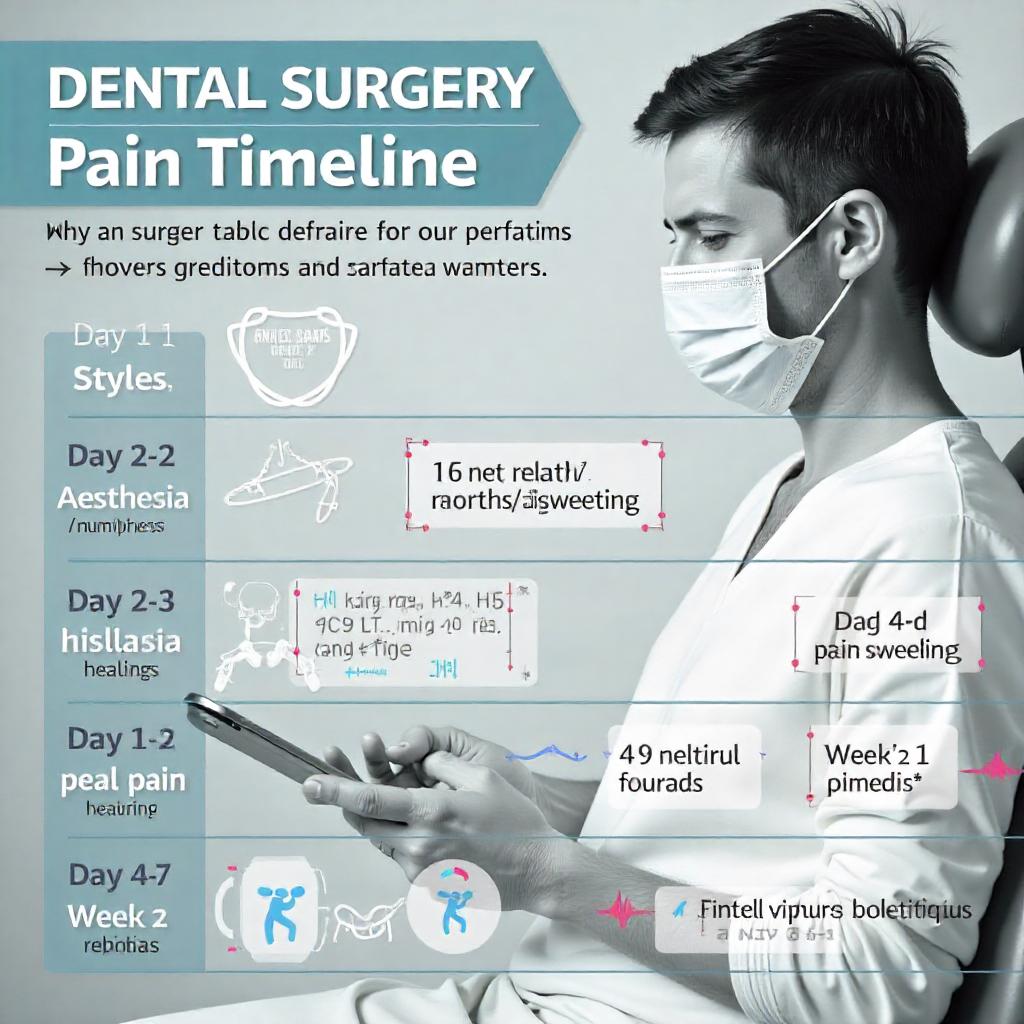Dental surgery, whether for wisdom tooth extraction, implant placement, or gum surgery, often comes with some level of discomfort. Understanding the timeline of pain can help you prepare for recovery and manage symptoms effectively. Below is a detailed outline of what to expect, day by day, including tips for faster healing.
What to Expect Immediately After Surgery (Day 1)
Right after dental surgery, it’s normal to experience swelling, tenderness, and localized pain. This discomfort is a result of tissue trauma during the procedure. Your dentist will likely prescribe pain relievers or recommend over-the-counter medications like ibuprofen to manage the discomfort.
Common Experiences on Day 1:
- Swelling and Bleeding: Mild bleeding is common and usually subsides within a few hours.
- Numbness: Local anesthesia may leave your face feeling numb for several hours.
- Pain Intensity: Pain tends to peak once the anesthesia wears off, typically within 3-4 hours post-surgery.
Tips for Day 1 Recovery:
- Apply an ice pack to reduce swelling.
- Avoid hot foods that can disrupt the clotting process.
- Stick to soft foods and liquids, like smoothies or broths.

Days 2-3: Peak Pain and Swelling
By the second and third day after surgery, pain and swelling often reach their peak. This is a normal part of the healing process as your body responds to the surgical site. You might feel a dull throbbing pain, which is manageable with prescribed or over-the-counter painkillers.
Symptoms During This Period:
- Swelling: May spread to the cheeks and jaw but will gradually decrease.
- Soreness: The surgical area will feel tender, especially when chewing or talking.
- Bruising: Some light bruising around the jawline can occur.
Pro Tips for Managing Days 2-3:
- Continue using cold compresses, switching to warm compresses after 24 hours.
- Maintain good oral hygiene, avoiding the surgical area when brushing.
- Stay hydrated and avoid alcohol or smoking, which can delay healing.
Days 4-7: Gradual Improvement
Most patients notice a decline in pain and swelling by the fourth day. This phase marks the beginning of tissue repair. While soreness is still present, it becomes less severe with each passing day.
Key Developments:
- Pain Reduction: Pain transitions from acute to mild or moderate.
- Wound Healing: You may notice slight itching or pulling in the surgical area as tissues begin to close.
- Diet Advancement: Start introducing soft-solid foods like scrambled eggs or mashed potatoes.
Recovery Tips:
- Rinse with warm saltwater to keep the area clean and promote healing.
- Avoid strenuous physical activity, which can increase blood pressure and delay recovery.
Week 2 and Beyond
By the second week, most patients experience significant improvement. Pain is minimal or gone altogether, and eating becomes more comfortable. However, full healing of the surgical site may take a few weeks to months, depending on the complexity of the procedure.
What to Expect:
- Minimal Discomfort: Only slight tenderness may remain, particularly in cases of wisdom tooth extraction.
- Stitches Dissolving: If dissolvable stitches were used, they typically disappear by the end of the second week.
Long-Term Care:
- Follow up with your dentist if the pain persists or worsens.
- Avoid hard or crunchy foods that can irritate the area.
- Stick to post-operative care instructions to prevent complications like infection or dry socket.

When to Contact Your Dentist
While pain, swelling, and bruising are normal side effects of dental surgery, certain symptoms may indicate complications. Contact your dentist immediately if you experience:
- Severe or increasing pain after Day 3.
- Prolonged bleeding that doesn’t subside after applying pressure.
- High fever or chills, which could indicate infection.
- A bad taste in your mouth or persistent bad breath, which may signal dry socket.
Pain Management Innovations in 2025
Advancements in dental technology and pain management techniques have improved post-surgical outcomes. Here are some recent developments:
- Long-Lasting Anesthetics: New formulations provide extended pain relief, reducing the need for oral pain medications.
- Laser Surgery: Minimally invasive options like dental lasers reduce tissue trauma, leading to less post-op pain.
- Regenerative Gels: Bioactive gels applied to the surgical site can accelerate healing and minimize discomfort.
Discuss these options with your dentist beforehand if you’re planning any dental surgery.
Final Thoughts
Understanding the pain timeline after dental surgery can ease anxiety and pave the way for a smoother recovery. By following your dentist’s care recommendations, managing pain effectively, and monitoring your healing, you’ll return to normal activities in no time. Always remember, when in doubt, consult your dentist to ensure your recovery stays on track.




